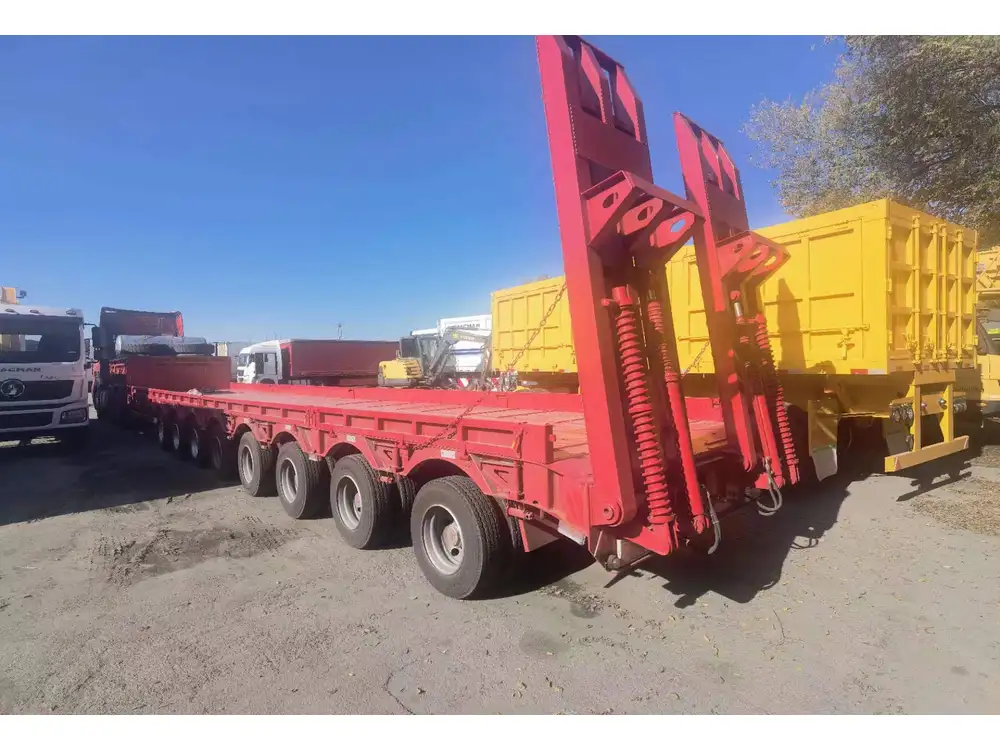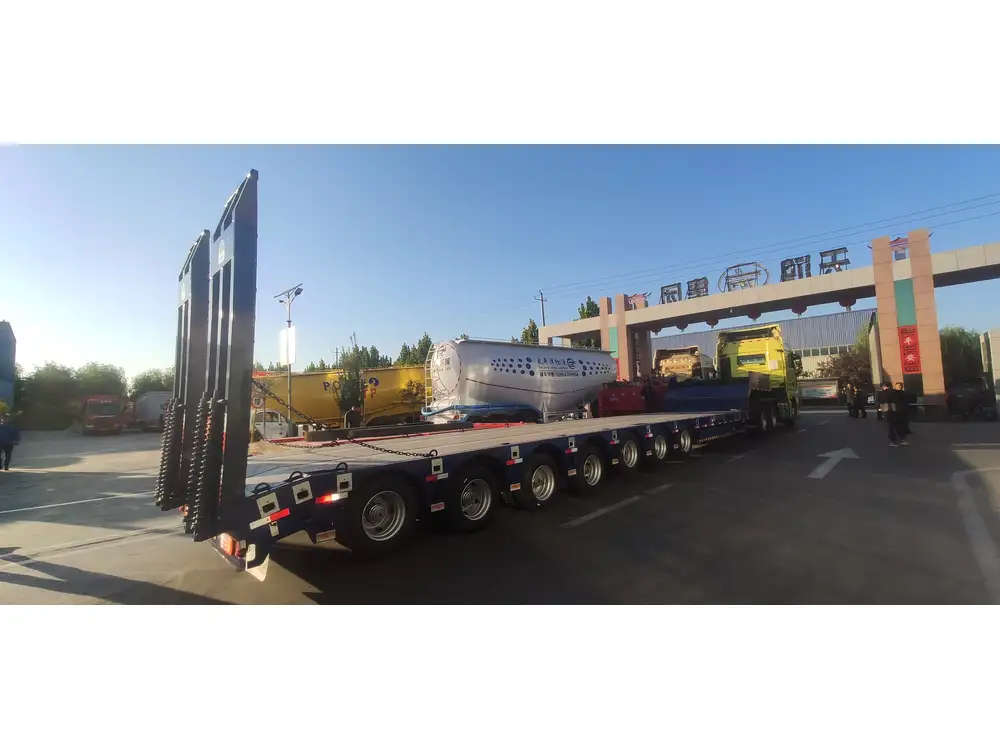Introduction to Flatbed Semi-Trailers
Flatbed semi-trailers have become indispensable in the logistics and transportation industries, primarily due to their versatile loading capabilities. Unlike traditional enclosed trailers, flatbeds allow for the easy loading and unloading of oversized and irregularly shaped cargo. This article delves into the complexities associated with flatbed semi-trailer weights, addressing critical questions and considerations for manufacturers, transporters, and logistics managers.
How Much Does a Flatbed Semi-Trailer Weigh?
The weight of a flatbed semi-trailer can vary significantly based on several factors, including design specifications, material composition, and additional features. Here’s a breakdown of typical weights for different variants:
| Type of Flatbed Semi-Trailer | Average Weight Range (lbs) | Average Weight Range (kg) |
|---|---|---|
| Standard Flatbed | 4,000 – 5,000 | 1,814 – 2,268 |
| Heavy-Duty Flatbed | 5,000 – 8,000 | 2,268 – 3,629 |
| Lowboy Flatbed | 10,000 – 15,000 | 4,536 – 6,802 |
| Specialty Flatbed (Multi-Axle) | 15,000 – 25,000 | 6,802 – 11,340 |

Factors Influencing Weight
The weight of flatbed semi-trailers is influenced by:
Material Composition: Typically constructed from steel, aluminum, or a combination thereof, the choice of material significantly impacts overall weight. Aluminum trailers tend to be lighter, enhancing payload capacity.
Design Features: Standard features such as stake pockets, tie-down points, and specific axle configurations can add weight. For example, additional axles improve weight distribution but also contribute to increased mass.
Size and Dimensions: The general industry size for flatbed trailers is 48 to 53 feet in length and 102 inches in width. However, custom sizes are available, which can alter weight parameters significantly.
Additional Equipment: Accessories like ramps, rails, and protective coverings can add several hundred pounds to the overall weight.
Load Capacity: Flatbed trailers are designed with specific legal weight capacities, typically ranging from 40,000 lbs to 48,000 lbs in the U.S. Importantly, a trailer’s own weight (tare weight) must be accounted for when calculating payload potential.
Legal Considerations for Weight
Understanding the regulations surrounding weight is crucial for anyone in the transportation industry. The U.S. Federal Highway Administration has established specific guidelines regarding maximum weight thresholds for trucks and trailers.
Key Regulations:
Federal Bridge Formula: The slope of weight distribution across axles is governed by a formula designed to prevent bridge and road damage.
State Regulations: Each state may impose its own regulations, including maximum road weight limits. Operators must ensure compliance with local laws to avoid fines and operational roadblocks.
Permits for Overweight Loads: For loads exceeding legal limits, special permits must be acquired, often incurring additional costs and logistical planning.

Importance of Understanding Weight for Operations
Enhanced Efficiency
Knowing the weight of a flatbed semi-trailer facilitates optimal loading practices. By understanding the maximum legal limits, businesses can maximize payloads while adhering to compliance standards, thus increasing revenue potential per trip.
Cost Implications
The weight of trailers directly impacts fuel efficiency. Heavier trailers typically consume more fuel—understanding this relationship can lead to informed decisions regarding equipment procurement and route planning.

Safety Considerations
Accurate weight distribution and trailer weight knowledge are integral to road safety. Overloading a trailer can lead to mechanical failure, accidents, and increased wear and tear, resulting in expensive repairs and operational downtime.
Mitsubishi vs. Freightliner: A Comparative Analysis
For fleet managers and logistics personnel shopping for flatbed semi-trailers, it’s essential to make informed choices between different brands. Let’s compare Mitsubishi and Freightliner, considering weight capacities, durability, and maintenance costs.
| Feature | Mitsubishi Flatbed Semi-Trailer | Freightliner Flatbed Semi-Trailer |
|---|---|---|
| Typical Weight Range | 4,500 – 6,000 lbs | 5,000 – 8,500 lbs |
| Weight Distribution | Optimized for uniform load distribution | Advanced suspension for better weight handling |
| Durability | Recommended for medium-duty applications | Ideal for heavy-duty and long-haul operations |
| Fuel Efficiency | Moderate fuel consumption | Known for superior fuel efficiency |
| Maintenance Cost Estimation | Lower maintenance frequency | Higher maintenance costs due to complexity |
Insights for Buyers
- Load Capacity Needs: Consider how frequently the trailer will carry maximum payloads.
- Operational Environment: Choose a brand based on the terrain and nature of the goods transported.
- Overall Cost of Ownership: Evaluate long-term costs rather than initial price alone.

Weight Management Solutions
To optimize the operational weight of a flatbed semi-trailer efficiently, consider implementing the following strategies:
Advanced Weight Monitoring Systems
Investing in onboard scales or weight monitoring systems can provide real-time data regarding trailer weight and load distribution. This technology helps to prevent overloads and ensures compliance with weight regulations.
Effective Load Planning
Careful planning before loading—taking into account the weight distribution and location of cargo—can maximize trailer efficiency. Use comprehensive loading diagrams to optimize balance and reduce the risk of weights shifting during transit.

Regular Maintenance Checks
Routine inspections can mitigate the risk of overloaded equipment. Frequent assessments ensure that all components are functioning properly and that no excessive wear is occurring due to weight stresses.
Conclusion
Understanding the weight of flatbed semi-trailers—along with the implications of that weight on logistics, regulations, and safety—is paramount for any stakeholder in the transportation sector. It informs purchasing choices, enhances operational efficiency, and facilitates compliance with legal frameworks.
In a rapidly evolving industry, remaining informed and adaptable can set your operations apart. By embracing advanced technologies, effective load management practices, and an analytical approach to trailer weight, we can significantly improve operational outcomes and drive profitability.
Additional Resources
- Weight Capacity Guidelines: Federal Highway Administration
- Load Distribution Standards: American Trucking Associations
- Trailer Maintenance Best Practices: Commercial Vehicle Safety Alliance
By acknowledging these aspects and employing efficient operational strategies, stakeholders in the transportation and logistics industries can ensure they not only meet the demands of the market but excel beyond baseline expectations.



